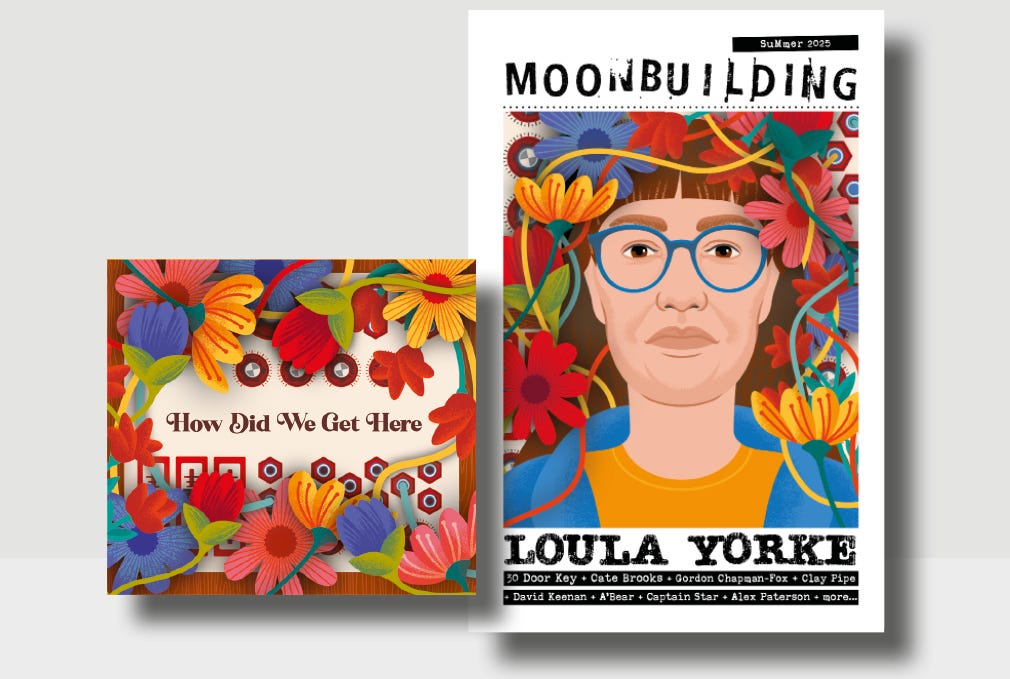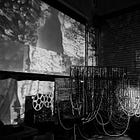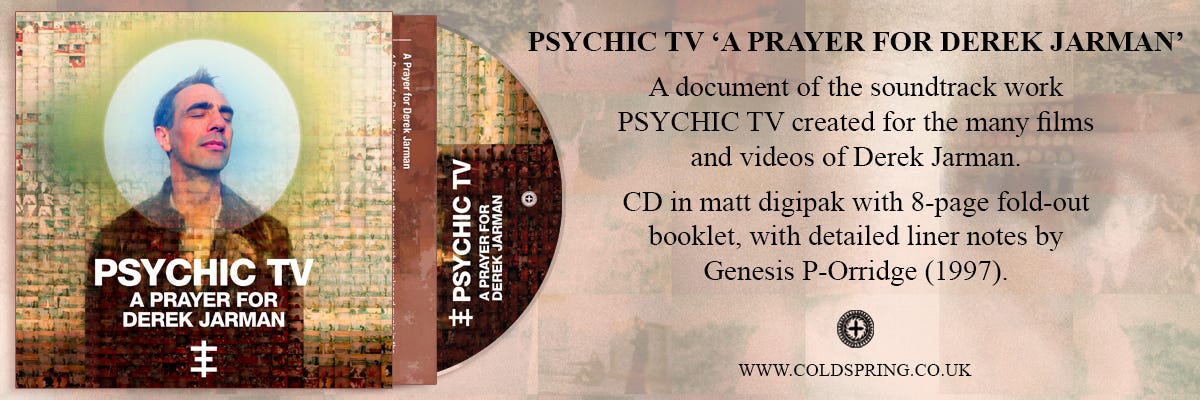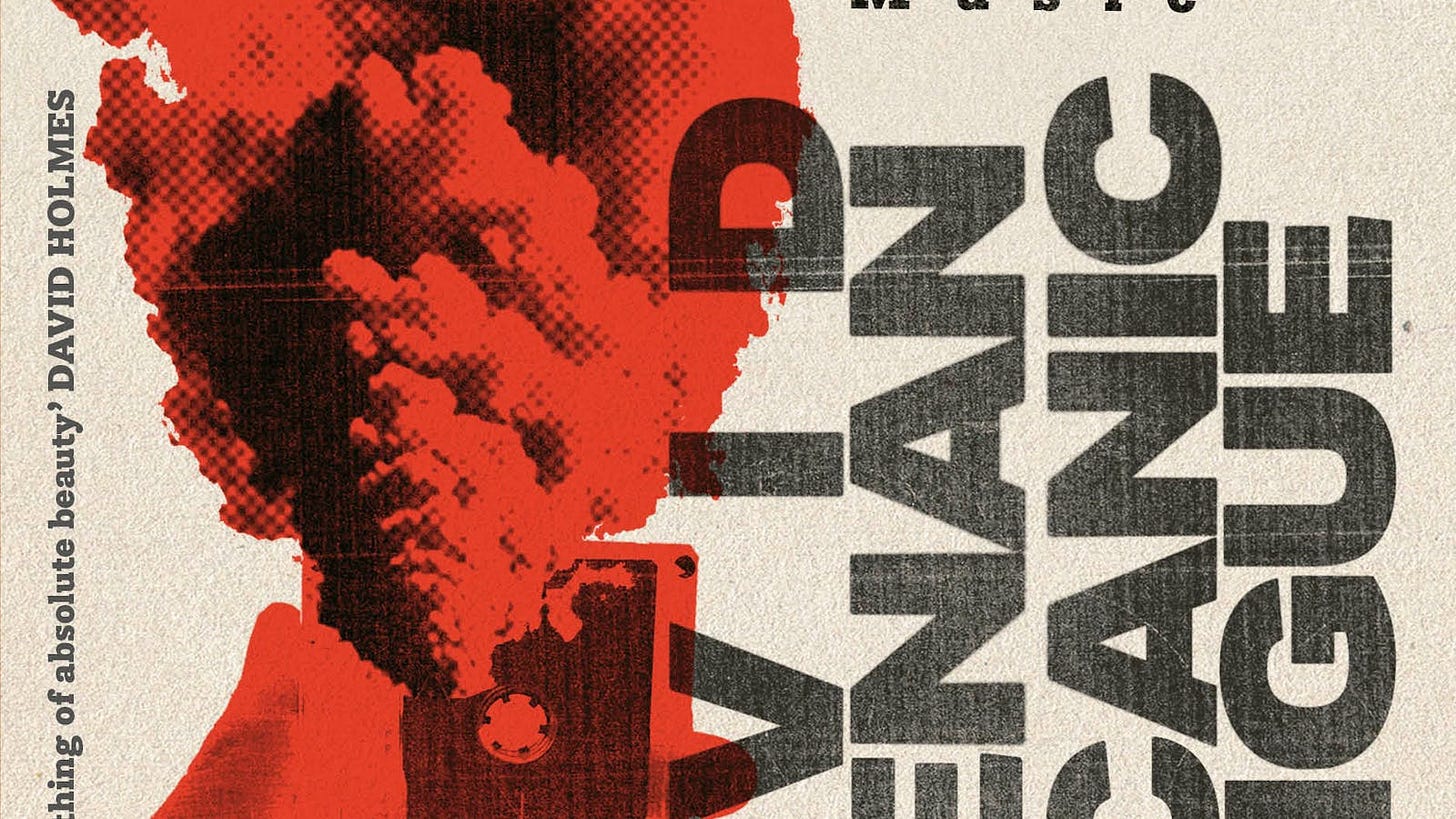Moonbuilding Part 2: Further on and farther out into the electric universe
Find Part one here:
1. Worlds within worlds beyond worlds
Back in September last year, I was VERY excited to receive two copies of Moonbuilding Magazine, with attached CDs, through my letterbox. I’d been recommended to check out the
Weekly Substack (of which more below), and discovered that Moonbuilding also publishes a magazine – a zine in the tradition of those old lithograph, screen print and banda machine produced things from the punk and post punk days. However, a couple of things separate out Moonbuilding (the mag) from those wonderfully and rebelliously thrown together zines – First, the design and visual quality of the thing – which is simple, punky and beautiful, and Second, the writing, knowledge and insight – which is well crafted, broad and impressive.Neil Mason, who puts the mag (and the Substack) together, is a veteran music journalist, and it shows. His longform profile and interview pieces are among the best I’ve come across. Witness his excellent interview with the artist pictured on the cover of the latest edition, Loula Yorke. It’s a beautiful piece that draws out Loula’s life in music and her influences, but it’s never sensational or intrusive. Everything he writes wants me to find out more about the subject or album or project, which is why I’m on to feature post number two on the Moonbuilding universe of DIY electronic music.
In his interview, Neil writes about meeting and talking with Loula Yorke in her far-away-from-anywhere studio. Here’s a video of her working in said studio, surrounded by flowers, on her last album, Volta. As a piece of performance art, the video is a beautiful thing in itself…
As Loula Yorke herself puts it:
“Welcome to my cottage studio! Pull up a chair ;-) This is a live jam of a 'work-in-progress' piece from my forthcoming album 'Volta'. In the past I've only recorded these as audio, but for Volta I've decided to record video and share them with you here on YouTube. For my notes, this is pattern B14, as yet untitled. What I love about doing these recordings is they help me track my changes across time, and give me a bit of distance from my usual 'in the moment' decision-making. I can listen back to hear what's hitting and what's missing. For this one, I want to make the lead melodic voice gentler in places – listening back, I realised I seem to only be using saw waves 😄”
More generally, and as a bit of a recap from my previous piece, DIY electronica is one of the most intriguing genres of popular music around at the moment. It has roots in electronic music experimentation and synth produced dance music and draws on both pop and classical structures as well as jazz, ambient, industrial post-punk and the evolving club scene over several decades. It’s made with modular analogue synths, as well as digital apps on bedroom computers, samplers, loops and other technology. It tips a hat to Aphex Twin, The Orb, Kraftwerk, Future Sound of London, Giorgio Moroder, Delia Derbyshire, Daphne Oram, Wendy Carlos and loads of others.
When I came across Moonbuilding (on Substack and in print), I was surprised and a little ashamed that I had heard of next to none of the artists. So, the ‘DIY Electronica’ universe could be said to be the underground of the underground. Even people who know a little bit about music history and culture can find that this music lies deep in creative warrens and needs unearthing. It’s produced by artists whose motivation isn’t fame or riches or stardom, but simply producing their music and art. Artists like Loula Yorke, Veryan and Polypores (aka Stephen James Buckley) are ultra prolific – working on and releasing myriad music projects and albums on small labels run by equally dedicated and obsessive lovers of this stuff. In short, no-one is going to get rich from DIY electronica. However, what they might be getting is the deep satisfaction of bringing their nuanced, forensic and endlessly creative music to the people (I was going to write ‘the masses’, but it’s a minority listening activity as well!).
It’s a strange experience listening to this music. On the surface it is, by definition, a repetitive genre. It works with patterns, drones, bleeps, sound waves, samples and simulations. It doesn’t always (though it sometimes does) work with beats – which are what drive electronic dance music and makes it so popular and addictive. Rather, DIY electronica relies on the ways the repetitions weave and interact with each other to make complex unexpected, beautiful, rhythmic and ultimately meaningful works. It’s more accessible than, say, experimental classical music (in my opinion), but at the same time it’s not ‘easy’, nor is it the kind of music you can always dance to (there are exceptions, Maria Uzor for one) or that turns up on your Spotify algorithm or mainstream radio station (unless it’s late at night on some obscure show or online). It lends itself to industrial chaos or else, ambience. Sometimes both…
Thinking about it, DIY electronica works a bit like poetry for me. Long form obscure poetry, maybe. Tracks can be extended meditations and improvisations on themes and landscapes. Sometimes they work best with a bit of knowledge of the source material as it originally turned up in the artist’s mind. For example, Craven Faults’ “Half-remembered journeys across post-industrial Yorkshire” make sense when you know about and can visualise the old mills and sprawling landscapes he is working with. Meanwhile, the black and white photography he uses to illustrate much of his work gives it context, if not explanation.
Veryan, another of my favourites from my first wave of discovery, works from the Scottish forest landscapes she lives amongst, and listening to her work evokes these places, and in turn what they might mean to her. She is also one of the artists who is always building projects and collaborations – releasing her own digital zines and putting them out on Bandcamp, alongside her albums and EPs. For his part, Gordon Chapman-Fox (aka Warrington-Runcorn New Town Development Plan, aka WRNTDP!) works intimately with urban themes and spaces. His “music for a broken concrete utopia” reflects on the social, cultural and political implications of these places, the ways they were intended to be used – in their original idealistic designs – and also what they have become.
His latest release, the Overspill Estates EP epitomises this approach, and All Mod Cons is a deeply evocative, nostalgic and emotional piece of work – made all the more so by the video that accompanies it.
I could argue that DIY electronica is making some of the most eloquent artistic and musical commentaries on modern day life and living. Through Moonbuilding and other sources, I’m becoming gradually familiar with how some of this emerges in the UK scene, but there are electronica ecosystems elsewhere of course, which do their own thing in their own cultural ways. The two first main labels I discovered – Castles in Space (based in the UK) and the ‘ambient adjacent’ A Strangely Isolated Place (based in the USA) – have artists on their roster from all over the world, from Germany, Sweden, Japan the USA, Europe and beyond. Much of the experimental beginnings of music like this came from post-war Germany and the experimental edges of progressive culture in the USA. There’s also a big scene in and around France with ambient pioneer, Molécule at its heart (who I discovered via the COVID pandemic era boxset, Music For Containment which Molécule curated and compiled and which was released through the Diggers Factory portal in 2020).
This track is from music for the surfing film, Sound of Surfing and Molécule’s EP Nazarre. It’s beat heavy and deeply immersive:
It’s a Universe, in other words, that stretches way beyond the boundaries of my own tip-of-the-iceberg explorations to date, and I’m going to continue to see what emerges on this specific strand of my musical journey. I’ll be patient with it, because that’s what this music demands – patience, slowness, attention to detail.
In return come rewards. In electronic music, I believe, there are patterns and rhythms that are deeply human, inherently connected and intricately ecological. Just as folk music – wherever it is played – has something of the local human cultural world and landscape woven into it, so the post-modern world – with its forests, cities, post-industrial environments, digital life and AI – can be found in the expression and interrelatedness of the drones, repetitions, samples and experimentations of electronica. Digital or analogue, at its most coherent and expressive, it carries the kinds of connection that folk has with the land and with history, but also reflecting and having room for the complexities of a world that has evolved and shifted way beyond the so-called ‘natural’ state that we sometimes try to reify and return to. Labels like Quiet Details, run by artist and musician/engineer, Alex Gold (aka fields we found), with its growing catalogue of physical and digital releases, epitomise this evolution of curiosity and complexity, inviting artists in this field to reflect upon aspects of life – as articulated by the phrase ‘quiet details’, the invitation it carries and the meaning and implications gleaned by each artist.
DIY electronica, therefore, might be the folk music of our times, the punk music of our times, the experimental edge of our culture – all at the same time. If that sounds too grand and pretentious, well, shucks, just shut me up and listen to some of the music I’ve selected for you that I’ve found in Moonbuilding the magazine and Moonbuilding the weekly Substack – and from a few other rabbit holes I’ve been down along the way.
I’ve also been listening to Jo Johnson’s album in the Quiet Details series, Escape Now, and my featured track is Stop The Transmission. Find the album on Bandcamp here, together with the full catalogue of Quiet Details releases:
2. Weekly musings and new Moonbuilding discoveries
Moonbuilding Weekly is a Substack publication – which means it sits on a platform with hundreds (thousands?) of other blogs and publications. For those I subscribe to, I get notifications each time there’s a new post. It’s a good system, but it can become overwhelming, and sometimes I just let it pass by when a new email comes through.
Moonbuilding Weekly is an exception. Each week, on a Friday, it comes through and there’s always something intriguing to read and follow up on, and I try to click through and check things out. There’s a track of the week and an in-depth album of the week review too. What is impressive about Moonbuilding is that while it’s a specialist project – editor Neil Mason has such a in depth knowledge of popular music as a whole – ands so he’s always making connections and diving into places I would least expect.
So, a one dimensional review of electronic ambient music this is not. The weekly Moonbuilding is a bit like reading an alternative music mag back in the day, and it tracks artists, like, say, David Boulter, who is in the band, Tindersticks, and who is also producing solo electronic and ambient albums full of evocative odes to his home city estate (St Ann’s) and English seaside resorts like Yarmouth and, most recently, Whitby.
This one is a long form track by Boulter on the Clay Pipe Music label: “My Mother started working in one of Nottingham’s lace factories when she was 15 years old, and was there until the early eighties, when most closed their doors for good… I have fond memories of watching the big factory in motion. The people, the sounds, the smell. It all seemed very exciting. I guess for the people who’d been working there all their lives - and could see an end to it - It had a very different feel. This music is inspired by my time sat in that corner of a world now gone.”
Anotherr example, from the most recent issue, is Lomond Campbell (a longtime collaborator of one of my current favourite singer/songwriters, Kathryn Joseph) who pops up with a Moonbuilding track of the week, remix of a track by former One Dove front woman and solo artist, Dot Allison.1
So, Moonbuilding does what Ziggy’s does, I guess. It travels down and through warrens of music deeper and more complex than Watership Down. It’s just that these rabbit holes are much more expansive, and sometimes harder to follow than my own! And there’s history too, held in Neil Mason’s archival brain and brilliant journalism.
Moonbuilding - the zine and the Substack – are both published in conjunction with electronica label Castles in Space, run by Colin Morrison, which champions, in particular, UK artists in this area of the woods: : “Think of us as the house magazine for independent DIY electronic artists and labels”, they write. However, Moonbuilding certainly doesn't restrict itself to the Castles in Space label, championing other indie labels like Woodford Halse, Clay Pipe Music and loads of others, as much as they highlight the artist themselves.
Even the adverts lead somewhere interesting, as I found out when clicking on one particular ad banner recently! This one was for a long deleted album entitled PSYCHIC TV: A Prayer for Derek Jarman, now re-released by the Cold Spring label.
It was produced by PSYCHIC TV aka Genesis P-Orridge and their collaborators as soundtracks for films and videos produced by polymath artist and LGBTQ+ rights activist Derek Jarman, and is a mesmeric example of the early cut up and sampling techniques pioneered in that era by P-Orridge and others, including fellow Throbbing Gristle artist, Cosey Fanni Tutti, whose new album was also previewed in Moonbuilding recently.
Here’s the wonderful Prayer for Derek from the album. I’ve been listening to this on repeat. It’s beautiful, spiritual and profound. According to the album website:
“The titular track, 'Prayer For Derek', is intended as an invocationary prayer, based on Tibetan rituals; a collage of sounds including field recordings of the lulling waves running aground on the shingle beach opposite Jarman's Prospect Cottage in Dungeness, Kent alongside bird song, crying babies, and massed ritualised chants to aid the late film director in his after-life journeys.”
And this is an edit of the excellent Stound from Cosey Fanni Tutti’s 2025 album, 212
And finally…
The thing about Moonbuilding is that there is almost too much to explore! That’s why the zine version is so helpful to me – it gives me an ‘in’ to the world that Neil Mason and Colin Morrison have curated, and the Substack helps me track and locate some of the new music that is always being created, like in a star factory in some distant galaxy.
Each time I open their weekly email, and especially when I open the packet with the magazine and attached free CD, I get excited, ready for a deep dive or journey of exploration. It’s been a temptation to go through the lot in this post – to tell you all about all the wonders that they are unearthing, but that would be silly. You can just go and find Moonbuilding for yourself – and you should!
As well as the music, there are book and zine reviews and all sorts of treasures. Just one example from the. most recent print issue, Neil talks to writer David Keenan about his new book about music, Volcanic Tongue: A Time-Travelling Evangelist’s Guide to Late 20th-Century Underground Music – and that’s definitely one for my Christmas list (yes I know it’s still only August!)
In the meantime, I’ll leave you with two final music recommendations. The first is the Loula Yorke playlist/CD that is included with the magazine. It’s a kind of overview of an artist at the height of her powers, and both the digital and CD versions are still available from Bandcamp. In the magazine itself, you can find an in-depth interview with Loula, a track-by-track description of the Moonbuilding playlist, and a listening guide to Loula Yorke - which includes her excellent 2024 album, Volta.
My second nod from the zine’s most recent issue is towards the oddly numerically monikered (Ar) 3d6 4s2 from Sarno Ultra’s eponymous 2025 album on the Bricolage Label. Sarno Ultra are Kayla Painter and Jon Worsley, collaboration here for the first time. The microbeats at the beginning of this track remind me a bit of Bjork’s Vespertine, but the album as a whole has a real contemporary club vibe and breakbeat sensibility. I said earlier that maybe you couldn’t dance to DIY Electronica – well I think Sarno Ultra are disproving my theory… I’m certainly moving right now…
Whatever… this is such a great album… and also I’d highly recommend the other ‘single’ from the album entitled, Such Eyes.
To be continued…
Look out for Part 3 of my journeys into the Moonbuilding DIY Electronica universe in the future. probably around the time they publish their next ‘zine!
Notes
Note and bonus: Here’s my Dot Allison story. Somewhere back in the swirl of the early 90s, Phil (of this Ziggy’s Lament parish) and I went to the T in the Park Festival in Strathclyde Park. It was the first T festival and took place at the cusp of the Britpop explosion. Blur, Oasis, Pulp, Manics, Primal Scream, Teenage Fanclub, and a whole host of others. We stayed in a tent in the back garden of a friend’s parents’ house in Hamilton. Saturday was awesome, but two things stick in my mind from the Sunday First, we missed Oasis (early in their career) because King Tuts Tent was way to full and we went to watch another band instead. However, earlier on that Sunday, I’d found myself in the tent watching a little known electronic dance-based band called One Dove who’d been signed to Andrew Weatherall’s Boys Own label. They were really good that day and Dot Allison was articulate, gorgeous and sparkly. I’ve got some photos somewhere, I think. All I’ll say is that there was somewhat of a dreamy clubby, vibe in the tent that afternoon, but I went away a fan. When Dot Allison brought out her first solo album in 1999, Afterglow, I really liked that too, but then lost track of her music. That’s fine, it only means I have some catching up to do!
As a bonus, I’ve linked to the opening track of that first solo album, which is entitled Colour Me. That bassy, triphop sound really takes me back… The video below that is a fascinating overview of her work since One Dove and her most recent projects.








Great piece - but also check out Electronic Sound issue 121 which has a comprehensive feature on the current electronic artists.